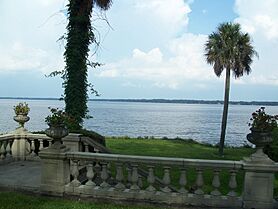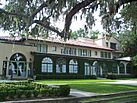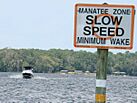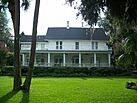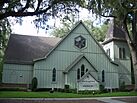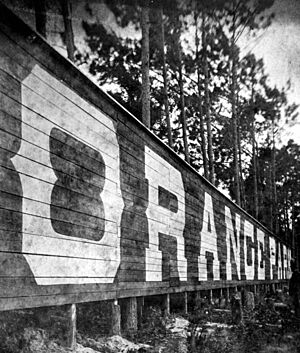Orange Park, Florida facts for kids
Quick facts for kids
Town of Orange Park
|
|
|---|---|
| Orange Park, Florida | |
|
View of the St. Johns River behind Club Continental
Club Continental
Doctors Lake
Orange Park Town Hall
Orange Park Mall
Winterbourne
Grace Episcopal Church
|
|
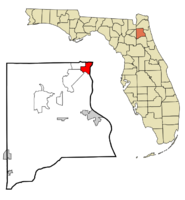
Location in Clay County and the state of Florida
|
|
| Country | |
| State | |
| County | Clay |
| Incorporated | 1877 |
| Government | |
| • Type | Council-Manager |
| Area | |
| • Total | 5.32 sq mi (13.78 km2) |
| • Land | 3.64 sq mi (9.42 km2) |
| • Water | 1.68 sq mi (4.36 km2) |
| Elevation | 13 ft (4 m) |
| Population
(2020)
|
|
| • Total | 9,089 |
| • Density | 2,498.35/sq mi (964.51/km2) |
| Time zone | UTC-5 (Eastern (EST)) |
| • Summer (DST) | UTC-4 (EDT) |
| ZIP codes |
32000-32099
|
| Area code(s) | 904, 324 |
| FIPS code | 12-52125 |
| GNIS feature ID | 0288219 |
Orange Park is a town in Clay County, Florida, United States. It's a suburb of Jacksonville, which is a bigger city nearby. Orange Park is part of the larger Jacksonville area.
In 2020, about 9,089 people lived here. That's more than the 8,412 people who lived here in 2010! The name "Orange Park" was chosen because the founders hoped to grow a lot of fruit. But a big freeze in 1894-1895 destroyed the crops, and the fruit industry never really came back to Orange Park.
Contents
History of Orange Park
Orange Park was once called Laurel Grove in the late 1700s. This name came from Sarah and William Pengree, who received land from the Spanish governor. After William died, Laurel Grove was sold to Zephaniah Kingsley, who owned the famous Kingsley Plantation. Zephaniah turned Laurel Grove into a successful farming plantation for over 10 years.
In 1813, during a conflict called the Patriots' Rebellion, Zephaniah's wife, Anna Madgigine Jai Kingsley, bravely burned down Laurel Grove. She did this to stop it from falling into the hands of the Patriots.
Founding the Town
The town of Orange Park was officially started in 1877 by a company called the Florida Winter Home and Improvement Company. After the Civil War, this company bought thousands of acres of land. Their goal was to create a nice southern getaway and a small farming community.
They divided the land into building lots and small farms. This is how the streets we see today, like Kingsley Avenue, were planned. The town became an official town in 1879. In January 1880, famous people like Ulysses S. Grant, a former U.S. President, and Philip Sheridan, a famous general, even visited Orange Park! A big hotel and a long pier were built along Kingsley Avenue.
The Great Freeze
In 1895, a very cold event known as the Great Freeze hit Florida. This freeze destroyed the fruit-growing businesses in Orange Park. Even though other areas recovered, the fruit crops in Orange Park never fully came back.
Schools and Research
In 1891, the Orange Park Normal & Industrial School opened. This school was special because it allowed both Black and white students to attend. At that time, it was the only school in Florida that was not segregated. However, because of unfair laws called Jim Crow laws, the school had to close by 1913.
Today, Orange Park Elementary School, built in 1927, is still open. It's located near River Road Historic District, a beautiful area with old trees perfect for walking. Close by is Club Continental, which was once a winter home for Caleb Johnson, whose family founded the Palmolive Soap Company.
In 1930, a scientist named Robert Yerkes started a research station in Orange Park. With help from Yale University and other groups, he studied how primates (like monkeys) behave. This lab was later moved to Georgia in 1965 and is now called the Yerkes National Primate Research Center.
Geography of Orange Park
Orange Park is located in the northeast part of Clay County, right on the St. Johns River. It's a suburb of Jacksonville, which is just north of Orange Park.
The area known as "Greater Orange Park" includes other nearby communities. These are places like Fleming Island, Ridgewood, Doctors Inlet, Orange Park South, Lakeside, and Bellair-Meadowbrook Terrace.
The town covers about 5.32 square miles (13.78 square kilometers). A good portion of this area, about 31.71%, is water. Many families in Orange Park have connections to the military because NAS Jacksonville, a naval air station, is less than 6 miles away. Many residents also work in healthcare.
Population of Orange Park
Orange Park has grown quite a bit over the years! In 1880, only 134 people lived here. By 2020, the population had grown to 9,089 people.
Here's a quick look at how the population has changed:
- 1880: 134 people
- 1950: 1,502 people
- 2000: 9,081 people
- 2020: 9,089 people
In 2020, there were 9,089 people living in Orange Park. These people lived in 3,361 households, and 2,271 of those were families. The town is a diverse place, with people from many different backgrounds living and working together.
Education in Orange Park
Orange Park is part of the Clay County School District. This means there are several public schools for students.
- There are three public elementary schools.
- There are two public junior high schools.
- There are three public high schools.
Many other public schools are just outside the town limits. Orange Park also has several private schools. For students looking for college, Fortis College has a campus here, and so does St. Johns River State College.
The closest public high schools are:
- Orange Park High School (about 1 mile west)
- Oakleaf High School (about 2 miles southwest)
- Ridgeview High School (about 3 miles south)
Notable People from Orange Park
Many interesting people have connections to Orange Park!
- Kat Cole: A successful business leader, once the CEO of Cinnabon.
- Dane Dunning: A professional baseball player in MLB.
- Steve Gaines: A former member of the famous band Lynyrd Skynyrd. He is buried in Orange Park.
- Hank Garland: A talented guitarist and songwriter.
- Nassir Little: A professional basketball player in the NBA.
- Terrance Plummer: A former NFL linebacker.
- Billy Powell: The keyboardist for Lynyrd Skynyrd.
- Shaquille Quarterman: An NFL linebacker who plays for the Jacksonville Jaguars.
- Ronnie Van Zant: Another former member of Lynyrd Skynyrd, also buried in Orange Park.
- Adrian White: A former NFL defensive back and coach.
- Dez White: A retired NFL wide receiver.
- Slim Whitman: A well-known country music singer-songwriter.
Transportation in Orange Park
Orange Park is built around two main roads: US 17 and Florida SR 224.
 US 17 is also known as Park Avenue.
US 17 is also known as Park Avenue. SR 224 is also known as Kingsley Avenue.
SR 224 is also known as Kingsley Avenue.
Park Avenue is the main street in Orange Park. It connects the town north to Jacksonville and I-295. Going south, it leads to the bridge to Fleming Island. Kingsley Avenue is another important street that connects Orange Park to the nearby community of Bellair-Meadowbrook Terrace.
Other important roads include Wells Road, which connects the northern parts of Orange Park and Bellair-Meadowbrook Terrace. Doctor's Lake Road connects Kingsley Avenue in Orange Park to Lakeside to the southwest.
Images for kids
-
View of the St. Johns River behind Club Continental
See also
 In Spanish: Orange Park (Florida) para niños
In Spanish: Orange Park (Florida) para niños


